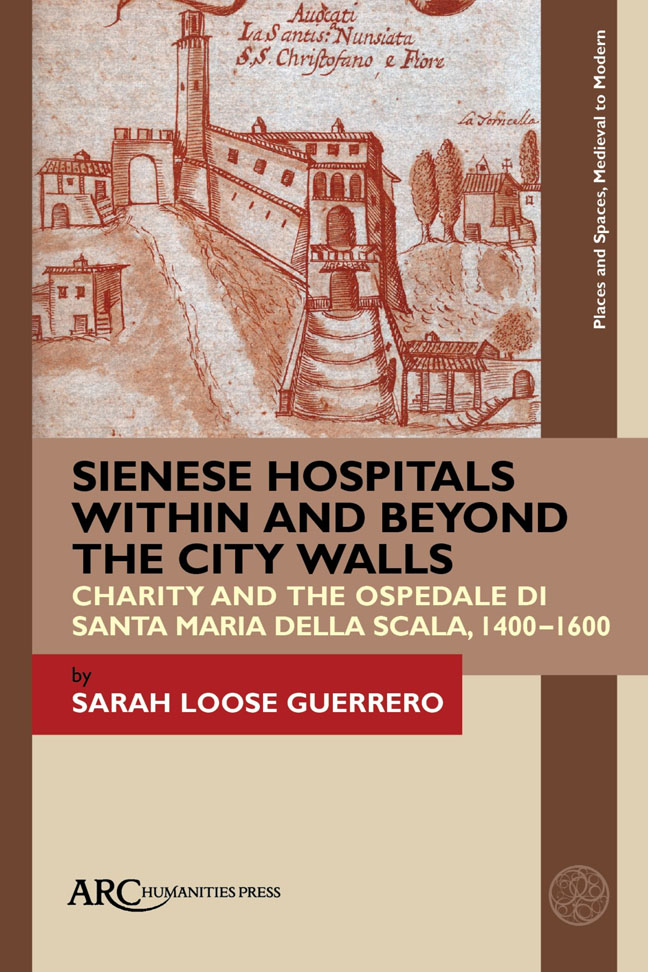 Sienese Hospitals within and beyond the City Walls
Sienese Hospitals within and beyond the City Walls Book contents
- Frontmatter
- Contents
- List of Illustrations
- Acknowledgements
- Introduction
- 1 A Most Pious House: Charity and Power in the City
- 2 An Extended Family: Rural Charity and Power in the Contado
- 3 Spaces of Charity Beyond Siena's Borders: The Spedali di Fuori
- 4 Charity and Power in Crisis: Shifting Dynamics
- 5 Power in the Granducato: Santa Maria della Scala and the Medici Grand Dukes
- Epilogue: Santa Maria della Scala's Spaces of Charity after 1600
- Select Bibliography
- Index
Epilogue: Santa Maria della Scala's Spaces of Charity after 1600
Published online by Cambridge University Press: 17 February 2024
- Frontmatter
- Contents
- List of Illustrations
- Acknowledgements
- Introduction
- 1 A Most Pious House: Charity and Power in the City
- 2 An Extended Family: Rural Charity and Power in the Contado
- 3 Spaces of Charity Beyond Siena's Borders: The Spedali di Fuori
- 4 Charity and Power in Crisis: Shifting Dynamics
- 5 Power in the Granducato: Santa Maria della Scala and the Medici Grand Dukes
- Epilogue: Santa Maria della Scala's Spaces of Charity after 1600
- Select Bibliography
- Index
Summary
After the turn of the seventeenth century, Santa Maria della Scala and its network continued to serve Siena and its contado for over two centuries. The hospital's property holdings did not expand, but the existing granges were maintained. It was not until September 26, 1775, when the grand duke of Tuscany Leopold II created a deputation for the alienation of Santa Maria della Scala's properties, that the hospital's rural spaces of influence began to be dismantled. This process took nearly twenty-five years to complete; the hospital archives kept records on most grance into the 1780s, the last official visit of the rector to the farms took place in 1790, and the sale of both land and property lasted until 1822. The only properties exempt from this order were the grance of Cuna and Serre. These the hospital maintained until the late 1800s.
As Santa Maria della Scala's power and influence in the countryside altered, the functions of the institution in the city adjusted as well. By the late eighteenth century, the hospital had been secularized; the last rector officially left office in 1861. This meant that some of Santa Maria della Scala's more religious charitable practices faded, includ-ing the distribution of food and alms to the poor, and sheltering pilgrims. The care of abandoned children, however, remained part of the hospital's mission into the 1930s and rural wet nurses continued to be employed into the 1910s. Across the seventeenth and eighteenth centuries the hospital's medical services grew increasingly important, so that in 1886 Santa Maria della Scala was joined to the newly restructured University of Siena and became a teaching hospital. Medical care and treatment were the central focus of the urban institution into the twentieth century and it remained Siena's main medical hospital until the construction of a modern structure outside city walls in the 1970s. It was not until the early 1990s that the last medical offices moved out of Santa Maria della Scala, and the buildings began a new life as museum and centre for cultural activities.
If you visit Siena today, you can explore a restored and, in some spaces, renovated, Santa Maria della Scala. Many parts of the urban structure allow visitors to experience aspects of the late medieval hospital, including the Pellegrinaio with its beautiful frescos, the sacristy, the corticella (little courtyard), the haylofts, and the underground road and storage rooms.
- Type
- Chapter
- Information
- Sienese Hospitals within and beyond the City WallsCharity and the Ospedale di Santa Maria della Scala, 1400-1600, pp. 171 - 174Publisher: Amsterdam University PressPrint publication year: 2023


